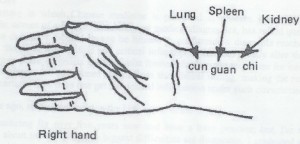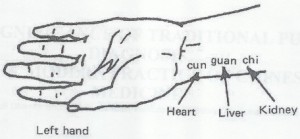One of the differences between Traditional Chinese Medicine (TCM) and Western medicine is that TCM puts more emphasis on prevention of diseases and identifying early symptoms of abnormalities that if untreated will lead to illnesses. A major technique, and probably the most important technique, is pulse analysis, where a TCM doctor puts his/her fingers on the wrist(s) of the patient and listen to subtle signals from the patient’s pulse. From pulse analysis, an experienced TCM doctor can determine not only whether the patient is well or ill, but also determine the patient’s relative health situation on the perfectly-good-health to critically-ill-health spectrum, as well as the part(s) of the body and the bodily organ(s) that may be experiencing abnormalities. This is the reason that the first thing that a TCM doctor does in examining a patient is to perform a pulse analysis. This article provides a layman’s introductory discussion of pulse analysis in TCM.
Pulse Analysis Pressure Points: A TCM doctor does not examine the pulse from a single point, but from three points on each wrist, thus totaling six points for two hands. A diagram of the pulse points can be found in the open-access article “Review of Traditional Chinese Medicine Pulse Diagnosis Quantification” by Anson Chui Yan Tang: http://cdn.intechopen.com/pdfs/40015/InTech-Review_of_traditional_chinese_medicine_pulse_diagnosis_quantification.pdf
If you want a larger diagram, just click on the diagram. These diagrams show that a TCM doctor puts three fingers on three adjacent spots on the radial artery of the patient’s wrist, called cun, guan, and chi. The width of each spot is about half an inch. Besides the fact that there are three different points on the wrist to get pulse information, the pressure applied at each point can be light, medium, or heavy. Therefore, each hand can give rise to nine different pulse information, or 18 different pulse information from both hands combined. For example, if pressed down strongly, these three spots on the right hand can provide information about the lung, spleen, and kidney respectively, and these three spots on the left hand can provide information about the heart, liver, and kidney respectively.
Note that the chi pressure point on the left hand can provide information about the kidney, and the chi pressure point on the right hand can also provide information about the kidney. However, in TCM there are two types of information associated with the kidney. One is more associated with the material or yin aspects (e.g., bodily fluids) of the kidney, and the other is more associated with the activities or yang aspects (e.g., force or motivation) of the kidney. It is also possible that information about additional organs can be obtained from a particular pressure point or combination of pressure points at a particular pressure level, but in this article we will not discuss such complexities and subtleties. [1]
Before continuing further, we need to keep in mind that the theoretical basis of TCM is that there is a life-force, called Qi, that resides and circulates within one’s body, and illnesses are due to the deficiency or excess, stagnation, imbalance, and blockage of Qi. Qi flows in various meridians (or channels) inside the body, and each meridian is associated with one or more organs. The status of Qi in various parts or organs of one’s body manifests in the person’s pulse, and a skilled TCM doctor can detect and differentiate the subtle differences of the Qi status by feeling the patient’s pulse.
Pulse Traits: There are many traits of the pulse that a TCM doctor listens to. These include:
- Frequency or speed: number of beats per respiration
- Strength: weak or pounding hard
- Shape: smooth or choppy
- Width: thin or broad
- Length: short or long
- Rhythm: regular or irregular
- Depth: Detectable at surface or deep level
For example, a slow, irregular pulse that skips beats irregularly may indicate deficient Qi or blood resulting in the heart not circulating blood properly. Taking into consideration that there are 18 points for collecting pulse information and there are many traits for each pulse, one can see that pulse analysis is a complex subject to master, and it requires many years of training under the teaching and guidance of experienced practitioners.
This complexity is also the value of pulse analysis and TCM. It can identify that there may be deficiencies or excess of Qi, or Qi blockages in certain parts of the body. This can lead to identify, or at least suggest, that there may be abnormalities brewing in certain organ(s). The abnormalities could be in the early stages and may not yet be detectable via Western medical exams, including exams by various instruments or blood tests. Because the abnormalities are just beginning to be formed, relatively speaking it is easier to correct and restore good health. For example, a change of diet, a change of lifestyle (e.g., more exercise, more rest, reducing stressful situations), adding some vitamins or other food supplements, or taking some herbal medicines may be sufficient to get rid of these early abnormalities and restore back to good health.
Pulse Analysis Is Part of a More Comprehensive TCM Analysis: It is important to note that pulse analysis is only one of several techniques used by TCM doctors, although it may be the most important technique. Pulse analysis is integrated with face analysis, tongue analysis, and analysis of personal information obtained via Q&A between the patient and the doctor. In TCM, it is emphasized that one does not treat the disease or condition, but rather one treats the individual patient. Thus two people with the same complaint may be treated very differently if their personal constitutions and situations are different.
Theoretical Foundation of TCM: TCM is based on the experiences of practitioners over more than 2,000 years, and TCM has developed a theoretical basis that is based on Qi and Qi circulation. During the last 30-40 years, there have been many medical/scientific research studies showing many health benefits of TCM and its associated activities such as acupuncture [2], Taiji [3] and [4], and Qigong [4]. However, from a modern scientific perspective, currently there is still no satisfactory theoretical foundation or explanation of TCM that is acceptable and commonly agreed to by medical and scientific researchers around the world. My personal opinion is that about 50-100 years from now, there will be definitive scientific evidence that there are legitimate healing powers from these ancient healing methods, and an explanation will be found that is based on modern science and that will be generally accepted by the world community.
We are not saying that TCM is better than Western medicine. There are many situations that Western medicine is better than TCM. However, we are saying that TCM can be a valuable alternative, complementary, supplementary diagnosis and treatment that can be fruitfully integrated with Western medicine to provide a better, holistic approach to better health. [5]
——————————————-
[1] The author thanks Qingyan Zhao for explaining some of the technical complexities of pulse analysis, but the author is responsible for any inaccuracy or ambiguity in this article.
[2] See, e.g., the World Health Organization article “Acupuncture: Review and Analysis of Reports on Controlled Clinical Trials,” 2003: http://apps.who.int/medicinedocs/en/d/Js4926e/5.html.
[3] See, e.g., “Health Benefits of Taiji”: http://www.dontow.com/2010/01/health-benefits-of-taiji/.
[4] See, e.g., “A Comprehensive Review of Health Benefits of Qigong and Tai Chi”: http://www.dontow.com/2010/12/a-comprehensive-review-of-health-benefits-of-qigong-and-tai-chi/.
[5] For a description of some of the author’s personal experiences of TCM, see “Myth or Reality”: http://www.dontow.com/2007/06/myth-or-reality/.



I appreciate your comments on how to deal with Japan. My friend, to whom I forwarded your mail, also appreciates your article on the study of the pulse in TCM.
One suggestion: it is respiration, not perspiration.
Thanks.
John,
Thanks for catching the typo. I have corrected it (perspiration –> respiration).
Don
Thks for introducing quite well for pluse analysis in TCM. There might be an additional trail for pulse, that is pulse tension. For instance, pulse during pregnancy would be slippery type which has a soft tension quality. Nice to read your article.
Thank you for your concise and interesting article.
I would like to propose that “chi” energy has in fact been scientifically validated. It is actually electrical energy that travels along certain pathways (meridians) in the body that connects different organs and systems.
This has been verified through the use of a device called “bio-well”, designed by the Russians over 20 years ago and with a lot of data to back up its claims. It has a website if you’re interested in looking it up for further information.